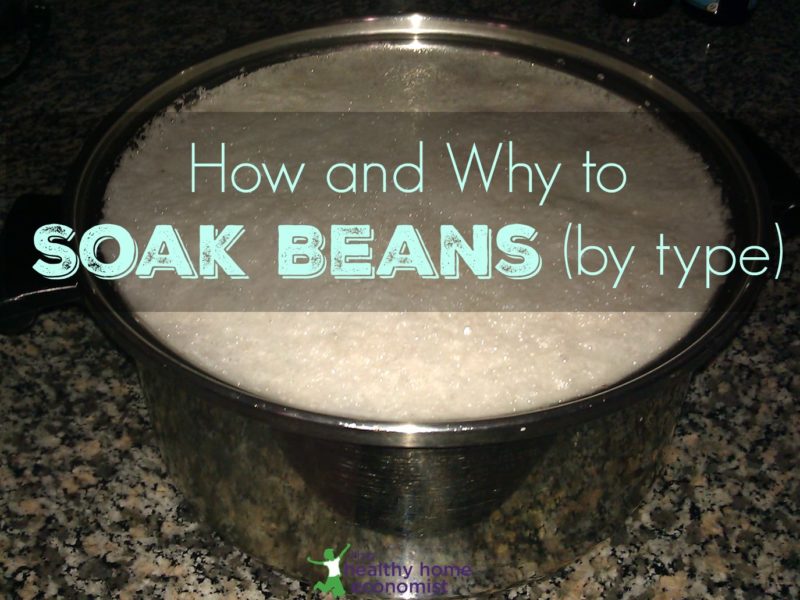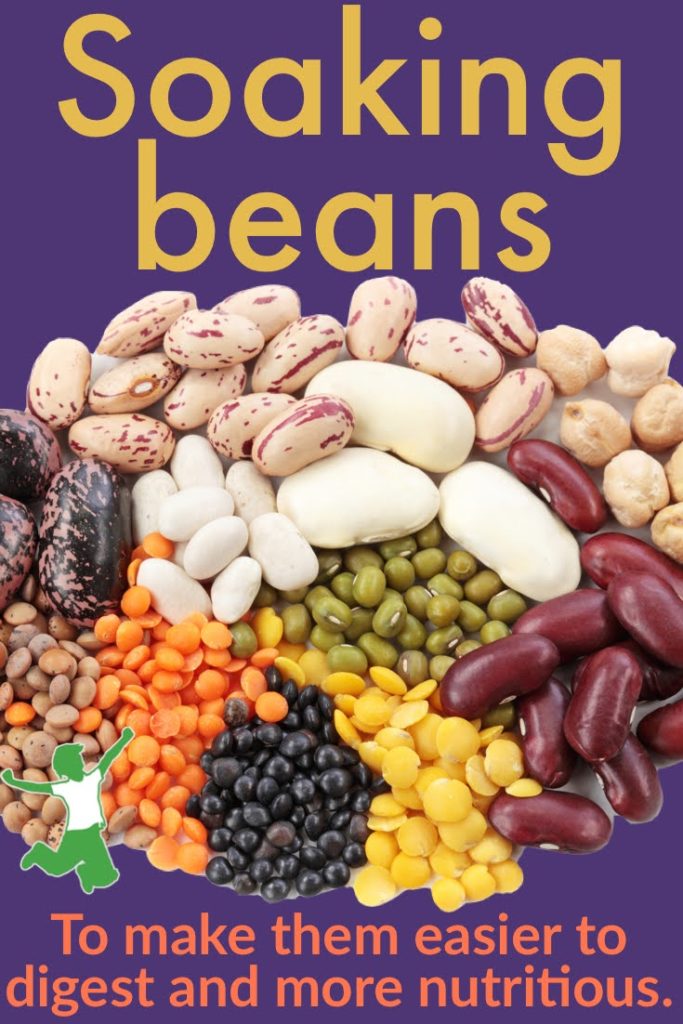Table of Contents[Hide][Show]
The simple overnight process of how to soak beans (by type) will help to eliminate gas and intestinal issues so you can enjoy eating these nutritious plant foods again!

I went on a bean soaking binge this past weekend, and the amount of scum that came to the top of the large pot of soaking kidney beans was so huge, I thought it deserved its own blog post. Soaking beans for many hours before cooking them produces a lot of scum which is course, is rinsed and drained away when the soaking is complete.
What is all that scum anyway? Anti-nutrients, that’s what! And those anti-nutrients such as phytic acid, lectins, and enzyme inhibitors are going to be in your gut causing you gas, heartburn, reflux, and whatever other digestive ills beset you when you eat something that isn’t particularly digestible unless you soak your beans before cooking them.
Traditional cultures took great care to prepare their legumes with a long soak before cooking to enhance digestibility and nutrient absorption.
I love Mexican food but really try to avoid Mexican restaurants for this reason .. they don’t soak their beans before cooking them!
After a meal at a Mexican restaurant, I will typically feel very bloated. Eating the same meal prepared at home where I soaked the beans properly before cooking results in no digestive upset whatsoever.
Take the Soaked Beans Challenge!
If you think unsoaked beans don’t cause you any trouble .. take this challenge. Soak beans next time before cooking and notice the difference in your stomach after eating.
You may think that the unsoaked beans don’t cause you any trouble, but you just may find that soaked beans are infinitely more filling and that you eat less and enjoy the meal more as a result!
Traditional peoples were very wise in the preparation of their foods. They not only selected nutritious foods but they prepared them for maximum digestibility and nutrition.
What good is eating nutritious legumes if the body is so whacked by the anti-nutrients that it can’t very easily extract and digest the nutrition?
So, the next time you make your beans, make sure you soak them first!
I soak large pots of various types of beans every month or so and then cook them – freezing for easy, quick meals when beans are required like homemade chili.
**If you absolutely do not have time to do this, at least buy pre-soaked legumes and beans packed in glass jars. Your digestion will thank you!
How To Prepare Beans by Soaking (video tutorial)
If you’ve never soaked beans before, it’s so easy. It’s a very similar process to soaking nuts. The method also mimics the wisdom of traditional societies that soaked seeds.
See this short video below that demonstrates the simple process.
Kidney shaped beans
For kidney shaped beans and dried/split peas, put a pinch of baking soda and enough water to cover in a large pot and soak uncovered for 12-24 hours. Drain, rinse and cook as usual.
Examples of kidney-shaped beans include:
- Red kidney beans
- White kidney beans (cannellini beans)
- Pinto beans
- Anasazi beans
- Black-eyed beans (black-eyed peas)
- Great Northern beans
- Lima beans
Non-kidney shaped beans (and other legumes)
For more oval-shaped beans and other legumes, soak for 12-24 hours in filtered water to cover plus 1 tablespoon of cider vinegar or lemon juice for every cup of dried beans/legumes used.
A homemade apple cider vinegar recipe or store-bought are both fine (make sure the ACV is packed in glass). Liquid whey from yogurt, kefir, or clabbered milk may also be used. Drain, rinse, and cook as usual.
Examples of non-kidney shaped beans include:
- Black beans (turtle beans)
- Navy beans
- Fava beans
- Adzuki beans
- Chickpeas
- Lentils
For maximum digestibility, it is best to rinse and refresh the filtered water and baking soda or the acidic medium once or twice during the soaking period. If you forget, no worries.
I try to always soak beans for the full 24 hours instead of just overnight. Sometimes if I get busy, I might even soak them 36 hours, but this is risky as they can get moldy sometimes if you go over 24 hours. Best to stay between 12-24 hours particularly during summer months.
How to Cook Beans After Soaking
After soaking, be sure to thoroughly drain and rinse the beans until all the scum is washed away. Then, complete the process by doing the following.
- Fill the pot of rinsed pre-soaked beans with fresh filtered water, bring to a boil, and skim away any additional foam that may come to the top at the start of the boil.
- Turn down the heat to a simmer, add 4 crushed garlic cloves, and cook until the beans are soft (about 4 hours).
- Drain beans and add to your favorite dish or let cool and freeze in large freezer bags for quick meals at a later date!
You won’t be needing over-the-counter gas meds after preparing beans the traditional way!
Should You Use the Soaking or Cooking Water?
Some alternative cooking circles advocate using the soaking or bean cooking water. Unfortunately, neither of these practices is traditional.
Using the cooked bean water or aquafaba is actually a dangerous practice. See the linked article for reasons to avoid this modern food especially during pregnancy!
Other Types of Legumes
This article plus video on soaking lentils provide additional information specifically for this legume. Because they are soaked exactly the same as all non-kidney shaped beans, it is helpful for visual learners.
Lentils were the favorite of nutritional pioneer Dr. Weston A. Price due to their very high potassium content.
Recipes Using Pre-soaked Beans and Legumes
Here are some recipes to try using soaked beans and other legumes to entice you!









latimes.com/food/dailydish/la-dd-dont-soak-dried-beans-20140911-story.html
–a bit of science, another option.
The title of this should be “Everything people believe about beans that’s been scientifically proven false”
Thanks so much for the information. I have tried it and really enjoyed my meal.
I’ve read about and have used another method that removes the anti nutrients which causes the gas and bloating. I recommended it to a friend whose husband insisted on making his chili beans without soaking the beans. Simply cook the beans for one hour and then drain and rinse the beans. Add fresh water and continue the cooking. That method has the same effect as soaking the beans overnight .
I have just been diagnosed with severe Gastritis. So, inflammation is a BIG problem. I am going to try this method you suggest today. Thanks for the info! 🙂
Great information!!!!!
I have never soaked beans before. I am going to start now. As i do have issues with the gas and belches afterwards.
Hi, I soaked a batch of chickpeas for 24 hours with a little ACV. Rinsed them and put them in a crock pot, it’s been 24 hours and they are still hard and don’t seem to be softening. Do you know what could cause this? Thanks kindly,
They may be too OLD.
hum… I’ve never soaked beans and I’ve also never had any gas or stomach issues from beans. I use a pressure cooker though. I just keep cookin em until they get soft. I’ve heard beano works well. I’m actually making unsoaked kidney bean beans in chili (and i salted and added tomato before hand). Breakin all the rules haha. Takes about an hour and 15 minutes at high pressure though as opposed to the 20 minutes of soaked beans w/ no acid in them.
You need to test your advice. I (against my better judgement, I cook for a living!), trusted your recommendation on the “add 1T raw apple cider vinegar per every c of navy beans”, and followed your direction on the soaking them as well. I am now standing in my kitchen, looking at my hungry family trying to explain why I tortured them all day yesterday with the smell of 2 lg ham bones and two ham hocks making stock, and still there is no US Senate soup (a recipe I know by heart from JOC❤️)! The beans look hydrated but WILL NOT SOFTEN AFTER 3 hrs of cooking!!! Now more research leads me to the national bean council and beans 101 which say NO ACID TILL LAST HOUR OF COOKING!!!! ???? What the heck? My only reason for NOT just “doin what I do best” was because of the gastrointestinal effect the beans have on two members of my clutch. Both girls, mind you. Shame on you, Internet! TMI. ???? So disappointing.
What type of beans do you use? With some beans, you use baking soda instead of ACV. I suspect this was the problem with the beans not softening up. Conventional cooking advice does not recognize the need to soak beans prior to cooking as was traditionally practiced, which probably explains why your source said only to add at the end.